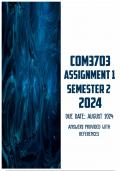, PLEASE USE THIS DOCUMENT AS A GUIDE TO ANSWER YOUR ASSIGNMENT
Please note that the author of this document will not responsibility for any plagiarizing you
commit.
Introduction
1. In the introduction, you should clearly identify/indicate what you will discuss in the
assignment and also how your assignment is going to be structured. You should refer to all four
themes/study units that you are covering in your assignment, as well as the particular topics
within the theme on which you will answer questions. Furthermore, if you are using any media
texts as examples in your answers to some of the questions, you need to identify those media texts
by name/title in the introduction.
In this assignment, I will explore four critical themes in media studies, drawing from specific
chapters in our prescribed book. Firstly, I will discuss media, language, and discourse (Chapter 3),
examining how media shapes and reflects societal discourses. Secondly, I will delve into film theory
and criticism (Chapter 8), analyzing various theoretical approaches and their application to film
criticism. Thirdly, I will explore questionnaire surveys in media research (Chapter 10), focusing on
their design, implementation, and significance in gathering audience data. Finally, I will investigate
methods of measuring media audiences (Chapter 12), considering both quantitative and qualitative
approaches. Throughout the assignment, I will reference relevant media texts to illustrate key points
and provide practical examples. This structured approach will allow for a comprehensive
understanding of each theme and its relevance to media studies.
Media, Language and Discourse
2.1. Define and discuss the following concepts and provide examples of each:
2.1.1. Text
A text is any written, spoken, or visual communication that conveys meaning. It can include books,
articles, speeches, advertisements, films, and social media posts, among other forms. Texts are the
fundamental units of communication that carry specific messages intended by the creator. For
instance, a newspaper article is a text that conveys information about current events, while a film
script is a text that tells a story through dialogue and action.
(Fourie - Page 102-103)
2.1.2. Discourse or discursive practice
Discourse refers to the ways in which language is used in texts and conversations to construct
meaning and social realities. Discursive practices are the patterns and conventions through which
discourse operates, shaping how individuals and groups communicate and understand the world.
These practices include the specific vocabulary, style, and structure of communication in various
contexts. For example, political discourse involves the use of rhetoric, argumentation, and persuasion
to influence public opinion and policy.
(Fourie - Page 104-107)





